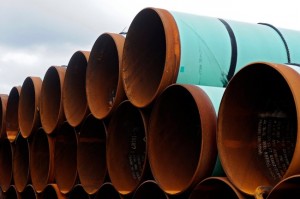Draft SEIS Released for Comment
From the Keystone XL Pipeline web-site of the U. S. Department of State:
On May 4, 2012, the Department of State received a new application from TransCanada Corp. for a proposed pipeline that would run from the Canadian border to connect to an existing pipeline in Steele City, Nebraska. The new application includes proposed new routes through the state of Nebraska.
The Department’s responsibility, under Executive Order 13337, is to determine if granting a permit for the proposed pipeline is in the national interest. We will consider this new application on its merits. Consistent with the Executive Order, this involves consideration of many factors, including energy security, health, environmental, cultural, economic, and foreign policy concerns.
In accordance with its interim guidance, the Department of State selected Environmental Resources Management (known as “ERM”) to serve as an independent third-party contractor for its environmental review of the proposed Keystone XL pipeline project. ERM is assisting the Department in conducting a thorough analysis of both the new route in Nebraska (in cooperation with the State of Nebraska) and any other relevant information that has become available.
On September 7, 2012, the Department of State received an environmental report from the applicant, TransCanada Corp. It is a normal part of the federal environmental review process for the private company applying for a permit to submit its own initial analysis of the environmental issues relevant to its proposal.
On January 22, 2013, the Department of State received notice from Governor Heineman of the State of Nebraska that he had accepted the route recommended by the Nebraska state route review process.
We are conducting our review in a rigorous, transparent, and efficient manner. We will continue to coordinate with relevant State and Federal agencies in the review of TransCanada’s new application for a Presidential Permit for the proposed Keystone XL pipeline.
UPDATE
- On March 1, 2013, the Department of State posted a copy of the Environmental Resources Management (ERM) contract and organizational conflicts of interest disclosures.
- The documents are available at http://keystonepipeline-xl.state.gov/admindocs/index.htm
- On March 1, 2013, the Department of State published a Media Note announcing the release of the Draft Supplemental Environmental Impact Statement. http://www.state.gov/r/pa/prs/ps/2013/03/205548.htm
- On March 1, 2013, the Department of State published a Fact Sheet regarding the release of the Draft Supplemental Environmental Impact Statement. http://keystonepipeline-xl.state.gov/draftseis/205549.htm
- On March 1, 2013, the Department of State released a Draft Supplemental Environmental Impact Statement (SEIS) for the new Presidential Permit application for the proposed Keystone XL pipeline.
- The Draft SEIS is available at: http://keystonepipeline-xl.state.gov/draftseis/index.htm.
The Draft Supplemental Environmental Impact Statement has been prepared consistent with the National Environmental Policy Act (NEPA). The document is a draft technical review of potential environmental impacts. The Draft SEIS includes a comprehensive review of the new route in Nebraska as well as any significant new circumstances or information that is now available on the largely unchanged route in Montana and South Dakota. It also expands and updates information that had been included in the 2011 Final Environmental Impact Statement that was prepared for the previous Keystone XL application. It does not make any recommendations on whether the pipeline should be approved or denied.
Once the Draft SEIS has been published by the EPA, the public will have 45 days to comment on the document. Those comments can be addressed to the following mailbox: keystonecomments@state.gov.
NOTE: As published by FrackCheckWV on May 11, 2011, Dr. James Hansen of NASA and Columbia University concluded, after extensive studies on the Keystone XL pipeline, “going down this path is game over for the climate.”
SEE ALSO: The New York Times article is HERE. More information available on EcoWatch.


{ 1 comment… read it below or add one }
The Keystone XL pipeline is THE most dangerous single project for climate change. So much energy to get it out and into a form that will allow it to be moved through the pipeline, along with the possibility of over use, beyond what the planet will tolerate, are its characteristics.
Shale gas and oil will do more damage to the earth’s productivity, however, because most of it is inaccessible (less than 10% return) so the total carbon energy available is far less. It is the huge land surface area needed for shale development in populated and productive areas that makes it devastating.